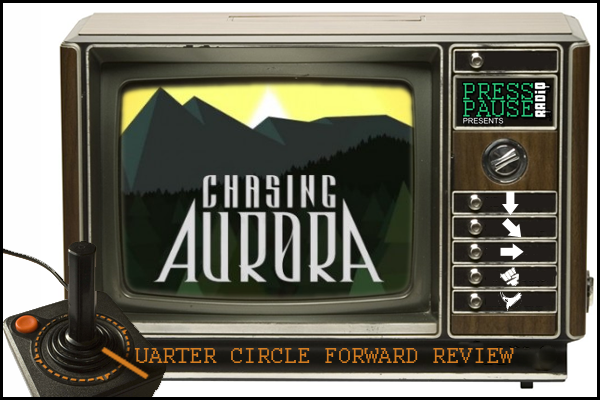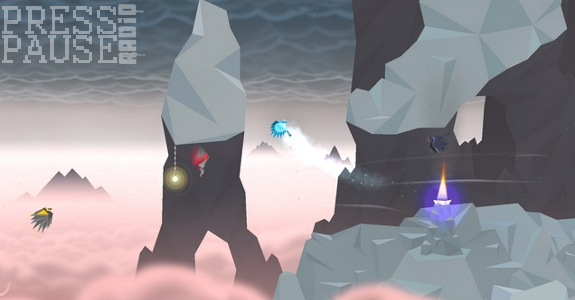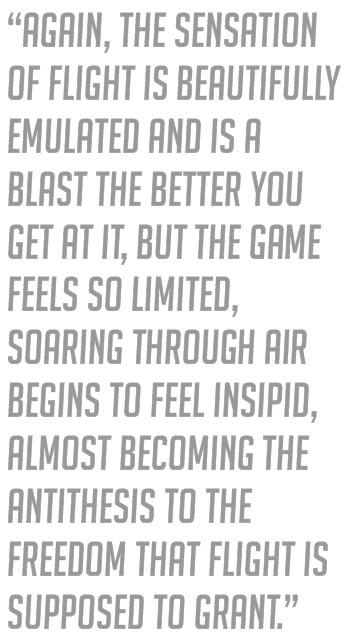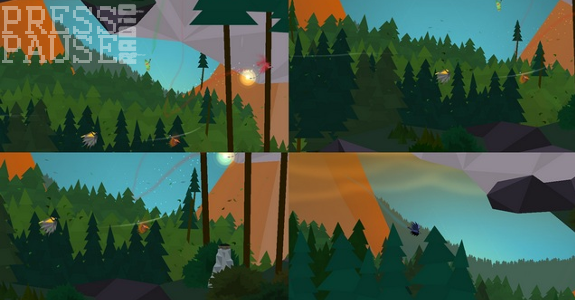
Broken Rules has volunteered to be the forerunner of independently developed game for the Wii U, an admirably brave task considering that larger, more experienced studios have been skeptical of their own ability to significantly take advantage of the Wii U’s potential. Nintendo's new console excels at offering a cavalcade of dynamics in a multiplayer setting, evident by the direction of Nintendoland.
Broken Rules therefore staked their hands at creating their software that centered on a competitive theme with their imaginative take on the philosophy of flight through the portrayal of paper art in Chasing Aurora. While the cliché of an indie studio taking the humble route in order to concentrate all production value towards the creative process and to convey a deeper meaning through a solid game mechanic, the Austrian studio takes this trait to heart, and it works both against them and in their favor in the end.
The simple nature of Chasing Aurora should go without mention, but it’s one of the most charming aspects of its design that translates to just about anyone who picks up the controller and plays. The subtle focus on mastering the physics to flying is rewarding in its own right, recognizing elements within the environment like an updraft. Picking the right motion of flaps through intricate button input conveys this tactile grasp of the games system of aerodynamics feels more satisfying the more you get the hang of it.

The visuals of Chasing Aurora come from a unique artistic perspective made up simple cutouts and shapes that make up the models and details of the levels and characters. The landscapes are delivered through layers and layers of perspectives within the environment that change with altitudes of flight that  add that finishing touch of elegance to the gratification that flying brings within the game. The soundtrack is a bit too plain, with most of them being ambient undertones or melodic strings of flutes and drums that do nothing more than play the role of background noise and nothing more. The bland soundtrack isn’t the only folly of this title, however, and among all the charm and whimsy of flying through its levels and sharing the experience with your friends, there is isn’t much else to it.
add that finishing touch of elegance to the gratification that flying brings within the game. The soundtrack is a bit too plain, with most of them being ambient undertones or melodic strings of flutes and drums that do nothing more than play the role of background noise and nothing more. The bland soundtrack isn’t the only folly of this title, however, and among all the charm and whimsy of flying through its levels and sharing the experience with your friends, there is isn’t much else to it.
The premise of Chasing Aurora is a series of challenges and multiplayer modes. You'll choose between assortments of avian heroes who participate in a series of competitive modes; the modes consisting of playing Hide and seek, Freeze Tag, and Free For All, which doesn’t really use the Gamepad much.
Hide and seek is where the Gamepad user has one screen to themselves, and a wider view of the level around them while the other players on the TV have to split their view in a traditional local multiplayer format and seek the Gamepad player and their gem before the time runs out. As the Gamepad player must safe guard the gem by either flying around with it or finding a hiding spot with the advantage of getting an individual view of the map over the others.
Freeze Tag is both the most frenetic and the more enjoyable of the three as the other Wiimote users must share the television screen and scroll with one another in order to stay safe from the Gamepad player who can freeze them with one touch. The Wii remote players must stick together to unfreeze one another, but still need to keep a safe distance in order to complicate the efforts of the Gamepad user from making one calculated swoop to victory. The gem also makes a return here, and will award additional points to any player who is holding on to it.
The last mode is Free For All. This mode consists of every player using the gem to play "keep-away," and with points awarded to the player who ends up having it when the time runs out. The main issues with the multiplayer involve a surprising lack of exposition. The point system is almost cryptic to an offensive degree, and there’s no explanation for how points are handed out at all. This flaw is hard to overlook during competitive play, and leads to instances where losing players still receive an unusually high amount of points, regardless of failed objectives. Stages are slight variations of previous ones as well, and with only these three modes, the multiplayer loses its appeal and quickly becomes redundant.

The single player game is incredibly uninspired, and only consists of time and score attacks modes. The campaign (if you can call it that) takes 45 minutes or so, and is twice as repetitive as the multiplayer mode. All you’re doing is flying through rings in a set track that you can’t deviate from at all. Again, the sensation of flight is beautifully emulated and is a blast the better you get at it, but the game feels so limited, soaring through air begins to feel insipid, almost becoming the antithesis to the freedom that flight should grant. The credits portion of the game is surprisingly the most liberal approach to freedom, and with the open stage design of flying through different nooks and heights in order to get through to the end, it’s a wonder why stages like these weren’t added in at all.
Chasing Aurora is a brave effort indeed, and one filled with incredible potential. But the experience is so short lived that it becomes difficult to recommend the title at a whopping $15, it’s a lot of Reggies considering how narrow the package. The experience is there, but too bad it’s a fleeting one.
